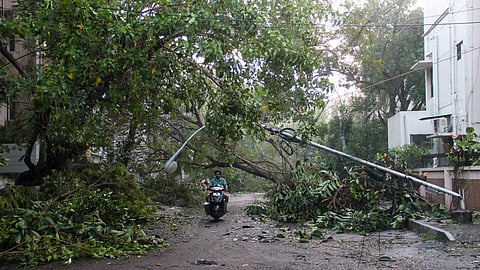
- Topics
- Feature
- Opportunities & Events
- About
- Hindi Portal
- Data
- Topics
- Feature
- Opportunities & Events
- About
- Hindi Portal
- Data

Cyclone Tauktae hit the west coast, while Yaas batters the east coast
Killing 104 people so far, cyclone Tauktae which formed in the Arabian Sea, was only the second ‘Extremely Severe Cyclone’ to hit Gujarat in 23 years. The cyclone made its landfall east of Diu on May 17 with wind speed ranging between 160–170 km/hr gusting to 185 km/hr. Tauktae was so severe that it not only affected five states — Kerala, Karnataka, Goa, Maharashtra and Gujarat along with two Union Territories — Lakshadweep and Daman & Diu, but its remnants caused rainfall up to Delhi, Bihar and Nepal.
Following Tauktae, another cyclone Yaas, originating over the Bay of Bengal, has hit Odisha and West Bengal coasts leaving a trail of destruction. According to India Meteorological Department, it weakened marginally immediately after landfall, but continued to be a very severe cyclone for a couple of hours. Although, Yaas caused widespread damage to both Odisha and West Bengal, it has pulled the monsoon current head in the Arabian Sea. (The Indian Express, Livemint, Hindustan Times, India Today)
2016-2018 drought in Southern India was the worst in 150 years: Study
According to researchers in India and the US, the 2016-18 drought that hit Southern India was the worst in 150 years as the region experienced over 40 percent deficit in the northeast monsoonal rainfall during the three years. The researchers examined the rainfall data over the past 150 years and concluded that the recent drought was worse than the Great Drought of 1874-1876 that led to the Great Madras Famine of 1876 to 1878 that claimed millions of lives.
The study has revealed that out of five of the major droughts that struck southern India over the past 150 years, four occurred during La Nina, a climate pattern that occurs irregularly every two to seven years. An independent expert has noted that the study, though unable to explain the reason behind the severity of the 2016-18 drought, has shown that natural climate variability can lead to extreme events and understanding these patterns can enhance the prediction of these events. (Mongabay India)
Environmental risks greatest for Asian cities: Report
As per the recent report from Verisk Maplecroft, Asian cities are at the greatest risks from environmental hazards like extreme heat, climate change and natural disasters. Out of the 100 cities worldwide that are at the risk of environmental hazards, all but one is in Asia while four-fifths are in India or China. The report found that across the globe, 414 cities, with a population of more than one million each, are at ‘high’ or ‘extreme’ risk from pollution, dwindling water supplies, deadly heatwaves, natural disasters and climate change.
While Jakarta, the Indonesian capital, has been named the riskiest city globally due to severe air pollution, Delhi comes next. The report further informed that India’s urban cities such as Delhi, Chennai, Jaipur, Lucknow, Bengaluru and Mumbai are among the top 30 places most at risk. (CNBC)
Uranium found in 83 percent of water samples in a nationwide survey
During a nationwide survey by the Bhabha Atomic Research Centre (BARC) for mapping of uranium content in drinking water sources across India, uranium was found in 83.6 percent of all the collected water samples. The study further revealed that out of 12 water quality parameters measured to understand the geochemical processes governing uranium content in water sources, eight were found to exceed the acceptable limits set by the BIS for drinking water. Moreover, dissolved uranium content in groundwater samples showed an upward trend with total dissolved solids and depth of water sources. However, no surface water samples exceeded the prescribed regulatory limit. (The New Indian Express)
The world is getting closer to the target of protecting 17 percent of Earth’s surface: Report
A report released by the United Nations Environmental Programme (UNEP) and the International Union for Conservation of Nature (IUCN) has informed that area of protected land on Earth has increased to seven times the size of India since 2010. This has brought the world close to meeting one of the goals of protecting 17 percent of Earth’s land, set at the 2010 Convention on Biological Diversity conference held in Japan’s Aichi prefecture.
However, the target of safeguarding 10 percent of marine environments worldwide still needs to be met. Despite the increasing protecting area across the world, biodiversity nevertheless is declining, with around one million species threatened with extinction. The report has revealed that conservation measures need to be more inclusive and to place less of a disproportionate burden on poor communities. (Mongabay)
This is a roundup of important news published from May 13 - 24, 2021. Also, read policy matters this fortnight.